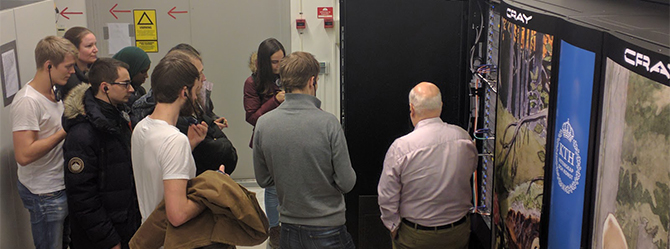Introduction to PDC Systems Course
Cristian Cira, PDC
The first Introduction to PDC course of 2017 took place on the 14th of February with ten postdoctoral researchers and Ph.D. students attending. They learned about the organization of PDC and its role in the Swedish National Infrastructure for Computing (SNIC) research community, as well as finding out about the overall mission of PDC and the staff that are available to help researchers using PDC’s high performance computing (HPC) resources. The course featured a tour of the computer room, which was followed by being given an overview of the architecture of PDC’s systems and the software available at PDC. Other topics that were covered included necessary basics such as instructions on getting individual accounts on PDC’s computer systems, applying for a time allocation on PDC’s computing resources (for doing a particular research project), submitting job allocation requests on specific computer systems at PDC (for running simulations and other jobs as part of a project’s total time allocation), and how to actually run specific simulations or applications.

For those of you who are not familiar with the SNIC terminology, it is useful to know that a time allocation is the total amount of run time (in terms of core hours – which mean one hour of run time on a CPU core) that research groups are granted when they apply to SNIC for computing resources to carry out a research project. (Note that a project that is undertaken with support from SNIC can have multiple time allocations at different high performance computing centres, as well as allocations for storage.) Once a research group is granted a time allocation for PDC (which will be for use on Beskow or Tegner), they can request a job allocation (that is, to be able to use a specified number of computing nodes for a period of time on the relevant computing resources) in order to run their code. The request for resources is handled by PDC’s job scheduler, which is called SLURM. Once SLURM grants the job allocation, the researchers can execute their code (which is generally referred to as running a job).